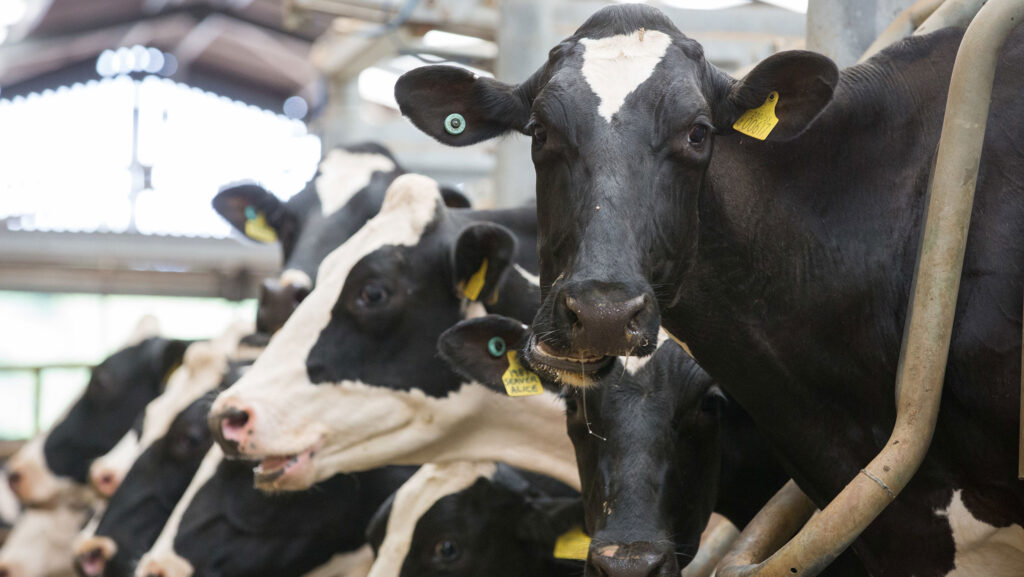In-parlour sniffer sensors could provide low-cost methane test
 ©Tim Scrivener
©Tim Scrivener Sensors that sample cows’ breath while they are feeding in the milking parlour could provide a simpler and more accurate solution to monitoring methane emissions.
The sniffer sensor technology has been developed by Newcastle University as an alternative to current methods, which tend to be costly, invasive, or interfere with cow behaviour.
Work is at the trial stage, says lecturer in ruminant nutrition Dr Hannah Davis.
See also: How feeding methane inhibitors can help cut emissions
The university’s commercial dairy unit at Nafferton Farm has been used as a test case, and proof-of-concept has been demonstrated for the technology and method of analysis.
“We want to make sure that farmers, advisers, consultants and industry bodies are able to make really well-informed decisions.
“Those informed decisions come from having access to good-quality data,” says Hannah, adding that this also involves not having to make broad assumptions about areas such as methane emissions.
The research has been funded by the National Innovation Centre for Rural Enterprise and the Department for Science Innovation and Technology 5G Innovation Regions.
How the sniffer sensors work
The project to measure methane and carbon dioxide emissions from the 250 Holstein Friesians at Nafferton Farm began in 2023.
Sniffer sensors were installed behind the feed troughs on one side of the 12:12 herringbone parlour. Samples from the cows’ breath were collected during afternoon milkings over a 12-month period.
A 6mm sampling tube, connected from the feeding trough to the sampling apparatus on the other side of the parlour wall, ensured no disruption to cows’ normal behaviour, explains Hannah Davis.
“Their head simply goes into the trough. We put the sensors behind the wall so the cows have no idea we’re collecting their breath and identifying and quantifying the concentration of gases.”
Vacuum pressure flushed out the tube between samples to ensure the gas measured was from a specific cow’s breath.
Initial findings
More than 1,300 methane samples were collected. “We immediately could see that there was a lot of variation [in methane levels] between cows,” says Hannah.
“The continued collection of data allowed us to look at what is ‘normal’ for these cows and consider how it varies by physiology, yield, stage of lactation or season.”
The research team then studied the samples at an individual cow level. “Now we’re starting to see if there is a normal range for a cow and how her individual physiology might be different from another cow.”
Hannah says the findings have laid the groundwork for comparison with other UK dairy farms and the implementation of mitigation measures such as feed additives.
Data access
In 2024, the project focused on connectivity and access to data. Funded by the Department for Science Innovation and Technology, and working with the Smart Rural Network, the research team set up a Loran 5G network on-farm to transmit the methane data.
The network has been linked with Microsoft Azure as a data-processing hub so the methane data can be connected with other information such as milk quality, yield, number of inseminations and days in milk.
These can be used together to inform better decisions on methane, explains Hannah.
“This project is set up in a way that allows longevity, so as new streams of data become available, for instance, through different trials, they can be visualised together.”
Next steps
The university has the capability and capacity to run “a huge range of trials looking at feed additives and different supplements”, says Hannah.
“We’re starting to look at selective breeding, how we can breed for better methane efficiency and identify cows who produce less methane overall.
“Continuous monitoring of emissions within a commercial dairy farm will allow us to bridge the gap between research and farm management.
“By trialling recommended additives or management practices we can establish whether these recommendations are effective in practice, on-farm, at scale.”
Future research will also include looking at any impact on animal welfare and behaviour when feeding cows methane-reducing supplements.
“If we’re supplementing cows with things that are aimed at reducing the methane concentration and methane quantity, is that having an impact on their behaviour, on their welfare?
“It’s important that we’re able to look at this as a whole,” says Hannah.
Hannah Davis was speaking at Dairy-Tech 2025
